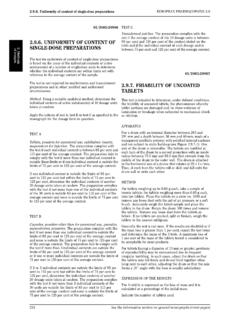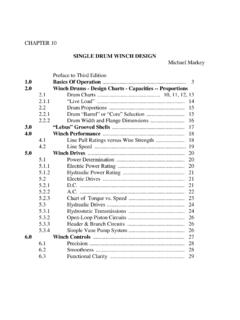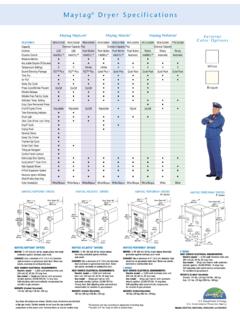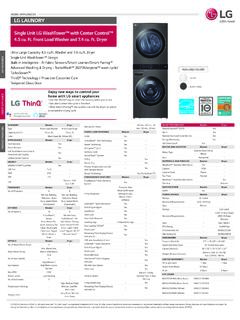Transcription of Guide to Drum & Percussion Notation - MIT
1 Allegrettorit. mp p f mp 3 Placement of Notes When drum part for a full kit part is placed on a 5-line staff, the parts played with the hands are notated with stems up, and those played by the feet with stems down. RL RR LRRL LRRLRetc 3333333333 3 Let Ring It is normally assumed that a cymbal will be allowed to ring unless a choke or stopped effect is indicated. However, if a number of choke symbols have been used, a tie may be added to make it clear that the note should be allowed to ring through its natural decay. Open Drums Similarly, most notes on drums are assumed to be played open unless the stopped symbol has been used.
2 The open symbol may, however, be used if it helps clarify the part. August 2004 Guide To drum & Percussion Notation 2 Guide to drum & Percussion Notation Notation for drums and Percussion varies considerably from arranger to arranger, and from publisher to publisher. Many notators have created their own symbols in an effort to cater for the huge array of Percussion instruments and techniques. In most drum Notation systems, the lines and spaces of a standard 5-line music staff are used to define the various drums of a kit. For simple parts (for example, a kick and snare pattern) a 1 or 2 line-line staff may be used.
3 Non-kit Percussion instruments can be notated on any of these staff types. Notators vary to some degree on what instrument each line of the stave represents. There is really no right or wrong as long as the notator provides a legend defining the meaning of each line of the staff, and the significance pf the different noteheads and symbols. The Guide you are now reading is a legend to how we notate drum and Percussion parts when we engrave music at Audio Graffiti. We attempt to follow the standards set out in Norman Weinberg s Guide to Standardized Drumset Notation . Occasionally we will introduce a new symbol to cater for an unusual requirement of a client.
4 In such situations, we will provide a custom legend in the score or part extract. SnareHi HatKickHiHat (Pedal)Open Tom 1 Tom 3 Tom 2 Ghost noteCrash (18") Ride (22")Ride (20") Splash (10")Rim Shot Rolls (8th-note) A slash through a note means that the drum should be struck repeatedly at 8th note (quaver) intervals for the duration of the note. This is usually as a standard double stroke roll. Rolls (16th-note) Two slashes through a note indicate that the drum should be struck repeatedly at 16th note (semi-quaver) intervals for the duration of the note, creating a roll. Rolls (triplet) If a number (eg 3 or 6) is placed above the notehead, the roll should be player as if it were a triplet or group of 6.
5 Rolls (on longer note values) The examples shown previously are all on a quarter not value. The slashes can be applied to any note value, and the roll should be played for the full duration of the note. For example, a half note (minim) with one slash requires four strokes. A dotted quarter note with one slash requires three strokes. equals 3 equals 3 equals 7 Rolls (32nd-note) Three slashes through a note indicate that the drum should be struck repeatedly at 32nd note intervals. equals Drags Drags are notated as a pair of grace notes attached to the main note. The grace notes are played using a different stick to the main note.
6 Flams Flams are indicated by a grace note. The grace note specifies which drum is to be struck slightly ahead of the main note. Ruffs These can be notated like a drag. However, if drags are also used in the same score, ruffs are distinguished by the alternate sticking pattern or by a slashed beam. equals equals RL 6 Triangle The triangle part can be noted on the 5-line staff by a triangle shaped notehead positioned on the first ledger line above the staff. They can also be notated on a single -line staff with either a triangle shape or a normal notehead. Muted triangles are notated with the stopped symbol, or, on a single -line stave they may be notated with a cross-shaped notehead.
7 Congas & Bongos Bongos and congas are normally notated on a two lined staff, with one line representing each of the drums. An additional line may be added for a third drum . The top line represents the highest-pitched drum . A cross-shaped notehead is used for muted drums. Specialist techniques should be defined in the legend. Woodblock these can be notated as triangle shapes on the upper section of the Percussion staff. The higher line represents the highest pitch. Woodblocks can also be notated on a one or two line staff with triangle or normal note heads. Normal Muted Normal Muted 6 Cowbell The cowbell is notated on the top space of the stave.
8 Muted cowbells can be notated with the stopped symbol. Cowbells can be notated on a single -line staff like the triangle. Gong Gongs are notated on the lowest line of the staff. They can also be notated on a single -line staff. Specialist techniques (such as scraping of brushes) should be defined in the legend. Kick/Bass drum The kick drum is notated on the bottom space of the staff. If a second kick drum is required, it will be notated on the lowest line of the staff. Snare The snare is notated as shown below. If a second snare is called for, it will be notated in a position used for one of the toms and this will be defined in the legend.
9 Toms (Standard kit) Three toms are notated for the standard kit: 2 mounted and one floor. Toms (Large Kit) Where more than three toms are required, they are notated in descending pitch. The appropriate size and type for each will be given in the legend otherwise these are left to player discretion. Toms (Additional) Up to 10 toms can be notated by adding the four definitions shown below to the large kit definition. Hi-Hat Closed The hi-hat is notated as a x-like cross mark on top of the staff. Hi MountedLow Floor Hi-Hat (Open) A small circle is placed above the hi-hat mark if it is to be struck while open.
10 Hi-Hat (Half Open) In some music, it is necessary to indicate a partially open hi-hat. This is done by placing a vertical line though the open 3 Hi-Hat (Second) Some arrangements call for a second hi-hat. This is notated inside the staff and lower than the first hi- hat. Bell or Edge Whether a cymbal is hit on the edge or bell is usually left to the discretion of the drummer. However the following symbols can be used if necessary. Ride Cymbal The standard position for a ride cymbal is on the top line of the staff. If a second ride is required, it is notated on the lower lines. Hi-Hat (With Pedal) A hi-hat played with the pedal is indicated by a cross mark below the stave.

















